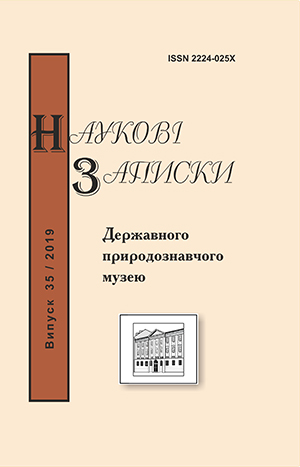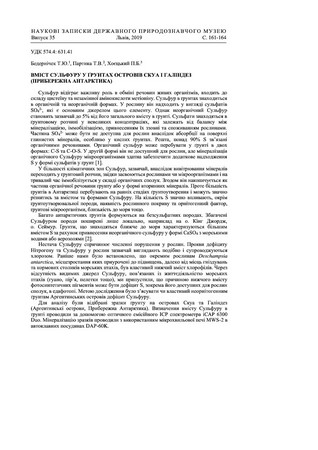Main
/
/
Bedernichek T., Partyka T., Khoyetskyy P. Sulfur content in the soils of Skua and Galindez Islands (Maritime Antarctic) // Proc. of the State Nat. Hist. Mus. - Lviv, 2019. - Vol. 35. - P. 161-164.
DOI: https://doi.org/10.36885/nzdpm.2019.35.161-164
Key words: Maritime Antarctic, sulfur, sulphur, cryogenic soils
Sulfur is an important nutrient, as well as a part of some aminoacids, enzymes and vitamins. The lack of sulfur in the plant organism is accompanied by a decrease of photosynthetic pigments content and, by external signs, resembles chlorosis caused by nitrogen deficiency. In Maritime Antarctica the main source of sulfur for terrestrial ecosystems are numerous ornithogenic products – guano, feathers, pellets, etc. However, many soils of this region do not contain visual signs of ornithogenous impact. The purpose of this study was to establish whether the sulfur content in these soils is the limiting factor for plant growth and development. It has been found that the total S content in both ornithogenic and non-ornithogenic soils is high, much higher than in the zonal soils of the temperate climate zone. Most of the sulfur is contained in the organic compounds and is not available for plants – more than 80% in ornithogenic and more than 90% in non-ornithogenic soils. It was found that the availability of sulfur is not a limiting factor for the growth and development of plants on the studied soils of Coastal Antarctica. We suggest that sulfur-containing organic substances play an important role as precursors of soil organic matter under Antarctic conditions.
References
- Scherer, H. W. (2009) Sulfur in soils. J. Plant Nutr. Soil Sci. 172, 326–335.
- Bockheim, J. G. (Ed.). (2015). The soils of Antarctica. Springer.
- IUSS Working Group WRB. 2015. World Reference Base for Soil Resources 2014, update 2015 International soil classification system for naming soils and creating legends for soil maps. World Soil Resources Reports No. 106. FAO, Rome.
- Zaimenko N.V., Bedernichek T.Iu., Shvartau V.V., Mikhalskaia L.N., Khoetckii P.B. Initcialnoe pochvoobrazovanie v Pribrezhnoi Antarktike: sushchestvuiut li neornitogennye pochvy? // Ukr. antarkt. zhurn. – 2016. – 15. – S. 170-175. [In Russian]
- Prietzel, J., Prater, I., Carlos Colocho Hurtarte, L., Hrbá ček, F., Klysubun, W., Mueller, C.W. (2019) Site conditions and vegetation determine phosphorus and sulfur speciation in soils of Antarctica, Geochimica et Cosmochimica Acta, doi: https://doi.org/10.1016/j.gca.2018.12.001
- Wang, J., Solomon, D., Lehmann, J., Zhang, X., Amelung, W. (2006) Soil organic sulfur forms and dynamics in the Great Plains of North America as influenced by long-term cultivation and climate.Geoderma 133, 160–172.
- Hofstee, E. H., Balks, M. R., Petchey, F. and Campbell, D. I. (2006) Soils of Seabee Hook, Cape Hallett, northern Victoria Land, Antarctica. Antarctic Sci. 18, 473–486.
- Zhu, R., Wang, Q., Ding, W., Wang, C., Hou, L., & Ma, D. (2014). Penguins significantly increased phosphine formation and phosphorus contribution in maritime Antarctic soils. Scientific reports, 4, 7055. DOI: https://doi.org/10.1038/srep0705
- Zaimenko N.V., Bedernichek T.Yu., Loia V.V., Mykhalska L.M., Shvartau V.V. Osoblyvosti formuvannia orhanichnoi rechovyny v initsialnykh gruntakh Pryberezhnoi Antarktyky // Fiziolohiia roslyn i henetyka. – 2018. – 50 (6). – S. 533-539. DOI: https://doi.org/10.15407/frg2018.06.533 [In Ukrainian]


